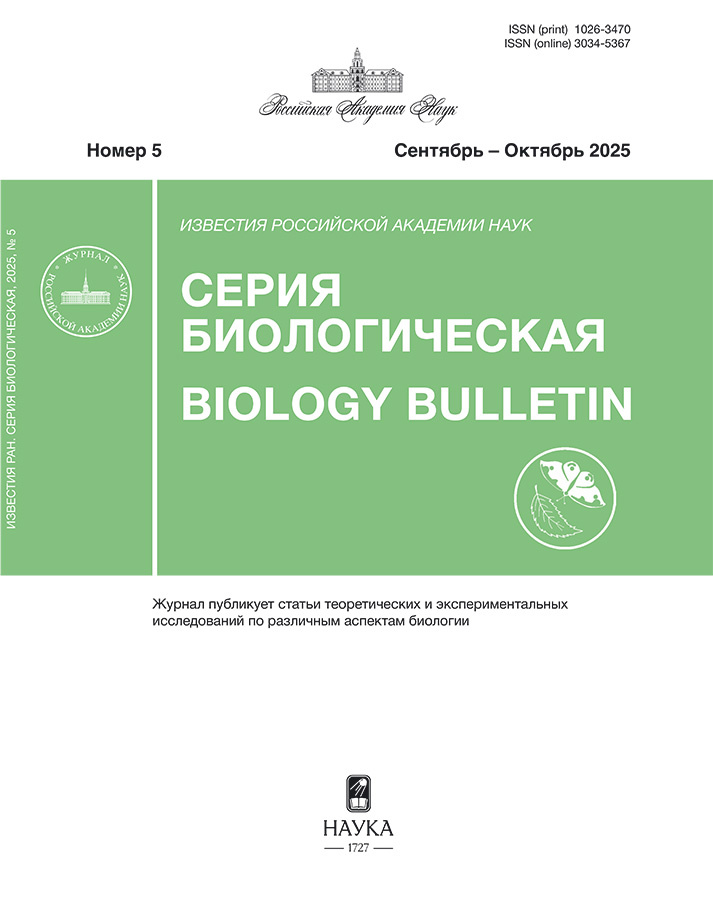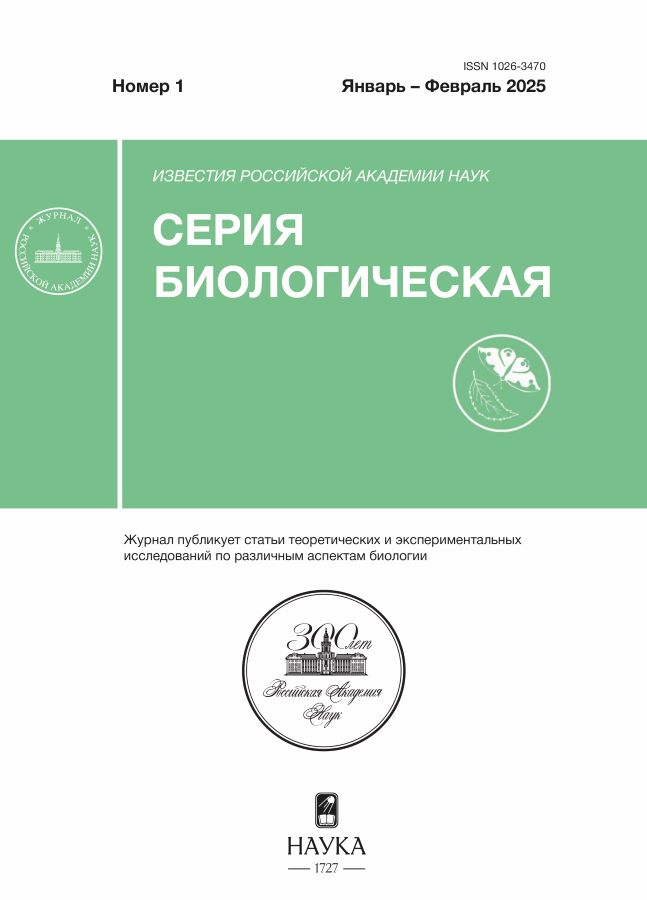Метгемоглобинредуктазная активность ядерных эритроцитов морского ерша (Scorpaena porcus, Linnaeus, 1758) в норме и в условиях окислительных нагрузок (эксперименты in vitro)
- Авторы: Солдатов А.А.1,2, Шалагина Н.Е.1, Рычкова В.Н.1, Кухарева Т.А.1
-
Учреждения:
- Федеральный исследовательский центр «Институт биологии южных морей им. А.О. Ковалевского РАН»
- Севастопольский государственный университет
- Выпуск: № 1 (2025)
- Страницы: 16-23
- Раздел: БИОХИМИЯ
- URL: https://rjeid.com/1026-3470/article/view/682146
- DOI: https://doi.org/10.31857/S1026347025010022
- ID: 682146
Цитировать
Полный текст
Аннотация
На примере Scorpaena porcus (Linnaeus, 1758) предложена методика оценки метгемоглобинредуктазной активности ядерных эритроцитов костистых рыб. В условиях эксперимента in vitro эритроцитарную взвесь данного вида взвешивали в растворах с различной концентрацией NaNO2, после отмывки от данного соединения изучали процесс восстановления метгемоглобина (MetHb) на протяжении 150 мин. О функциональном состоянии гемоглобина судили по результатам спектрального анализа. Изучение кинетики восстановления MetHb показало, что зависимость хорошо описывалась уравнением экспоненциальной функции при коэффициенте детерминации (R2) более 0.9. Характер зависимости сохранялся при различных уровнях окислительной нагрузки. Это позволило рассчитать константу скорости первого порядка k (25 оС). У данного вида она составила 5.75–6.45 (10–3) мин–1. Установлено, что MetHb-редуктазная активность ядерных эритроцитов морского ерша повышалась при увеличении окислительной нагрузки. При концентрации NaNO2 6.0 mM она составляла 1.73 ± 0.21 µM MetHb мин-1 г-1 Hb.
Полный текст
Об авторах
А. А. Солдатов
Федеральный исследовательский центр «Институт биологии южных морей им. А.О. Ковалевского РАН»; Севастопольский государственный университет
Автор, ответственный за переписку.
Email: alekssoldatov@yandex.ru
Россия, проспект Нахимова, 2, Севастополь, 299011; ул. Университетская, 33, Севастополь, 299053
Н. Е. Шалагина
Федеральный исследовательский центр «Институт биологии южных морей им. А.О. Ковалевского РАН»
Email: alekssoldatov@yandex.ru
Россия, проспект Нахимова, 2, Севастополь, 299011
В. Н. Рычкова
Федеральный исследовательский центр «Институт биологии южных морей им. А.О. Ковалевского РАН»
Email: alekssoldatov@yandex.ru
Россия, проспект Нахимова, 2, Севастополь, 299011
Т. А. Кухарева
Федеральный исследовательский центр «Институт биологии южных морей им. А.О. Ковалевского РАН»
Email: alekssoldatov@yandex.ru
Россия, проспект Нахимова, 2, Севастополь, 299011
Список литературы
- Andreyeva A. Y., Soldatov A. A., Mukhanov V. S. The influence of acute hypoxia on the functional and morphological state of the black scorpionfish red blood cells // In Vitro Cellular & Developmental Biology – Animal. 2017. V. 53. P. 312–319. doi: 10.1007/s11626-016-0111-4
- Benesch R. E., Benesch R., Yung S. Equations for the spectrophotometric analysis of hemoglobin mixtures // Anal. Biochem. 1973. V. 55. P. 245–248. doi: 10.1016/0003-2697(73)90309-6
- Blair B., Barlow C., Martin E., Schumaker R., McIntyre J. Methemoglobin determination by multi-component analysis in coho salmon (Oncorhynchus kisutch) possessing unstable hemoglobin // Methods. 2020. V. 7. № 100836. doi.org/10.1016/j.mex.2020.100836
- Gam L. T. H., Jensen F. B., Damsgaard C., Huong D. T. T., Phuong N. T., Bayley M. Extreme nitrite tolerance in the clown knifefish Chitala ornate is linked to up-regulation of methaemoglobin reductase activity. Aquat. Toxicol. 2017. V. 187. P. 9–17. doi: 10.1016/j.aquatox.2017.03.013
- Gladwin M. T., Kim-Shapiro D. B. The functional nitrite reductase activity of the hemiglobins. Blood. 2008. V. 112. P. 2636–2647. doi: 10.1182/blood-2008-01-115261
- Graham M. S., Fletcher G. L. High concentrations of methemoglobin in five species of temperate marine teleosts // J. Exp. Zool. 1986. V. 239. P. 139–142. doi: 10.1002/jez.1402390117
- Jensen B., Fago A. A Novel Possible Role for Met Hemoglobin as Carrier of Hydrogen Sulfide in the Blood // Antioxidants & Redox Signaling. 2020. V. 32. № 4. P. 258–265. doi: 10.1089/ars.2019.7877
- Jensen F. B., Nielsen K. Methemoglobin reductase activity in intact fish red blood cells // Comp. Biochem. Physiol. Part A: Mol. & Integ. Physiol. 2018. V. 216. P. 14–19. doi.org/10.1016/j.cbpa.2017.11.004
- Maestre R., Pazos M., Medina I. Involvement of methemoglobin (MetHb) formation and hemin loss in the pro-oxidant activity of fish hemoglobins // J. Agric. Food Chem. 2009. V. 57. P. 7013–21. doi: 10.1021/jf9006664
- Mansouri A., Lurie A. A. Concise review: methemoglobinemia. Am. J. Hematol. 1993. V. 42. P. 7–12. doi: 10.1002/ajh.2830420104
- Powell M. D., Perry S. F. Respiratory and acid-base pathophysiology of hydrogen peroxide in rainbow trout (Oncorhynchus mykiss) // Aquat. Toxicol. 1997. V. 37. P. 99–112. doi.org/10.1016/S0166-445X(96)00826-0
- Power G. G., Bragg S. L., Oshiro B. T., Dejam A., Hunter C. J., Blood A. B. A novel method of measuring reduction of nitrite-induced methemoglobin applied to fetal and adult blood of humans and sheep // J. Appl. Physiol. 2007. V. 103. P. 1359–1365. doi: 10.1152/japplphysiol.00443.2007
- Sajiki J., Takahashi K. In Vitro Formation of Methemoglobin by Lipophilic Fractions in Fishes and the Causative Substance // Eisei-Kagaku. 1991. V. 37. P. 467–472. doi: 10.1248/JHS1956.37.467
- Saleh M. C., McConkey S. NADH-dependent cytochrome b5 reductase and NADPH methemoglobin reductase activity in the erythrocytes of Oncorhynchus mykiss // Fish Physiol. Biochem. 2012. V. 38. P. 1807–1813. doi: 10.1007/s10695-012-9677-2
- Schechter A. N. Hemoglobin research and the origins of molecular medicine // Blood. 2008. V. 112. P. 3927–3938. doi: 10.1182/blood-2008-04-078188
- Soldatov A. A. Physiological Aspects of Effects of Urethane Anesthesia on the Organism of Marine Fishes // Hydrobiol. J. 2005. V. 41. P. 113–126. doi: 10.1615/HydrobJ.v41.i1.130
- Soldatov A. A. Cases of a Spontaneous Increase in Methemoglobin Concentration in Fish Blood during the Annual Cycle // Inland Water Biology. 2023. V. 16. P. 769–775. doi.org/10.1134/S1995082923040181
- Sztiller M., Puchala M., Kowalczyk A. et al. The influence of ferrylhemoglobin and methemoglobin on the human erythrocyte membrane // Red. Rep. 2006. V. 11. P. 263–271. doi: 10.1179/135100006X155012
- Tiihonen K., Nikinmaa M. Short communication substrate utilization by carp (Cyprinus carpio) erythrocytes // J. Exp. Biol. 1991. V. 161. № 1. P. 509–514. doi: 10.1242/jeb.161.1.509
- Welbourn E. M., Wilson M. T., Yusof A. et al. The mechanism of formation, structure and physiological relevance of covalent hemoglobin attachment to the erythrocyte membrane // Free Rad. Biol. Med. 2017. V. 103. P. 95–106. doi.org/10.1016/j.freeradbiomed.2016.12.024
- Woo S. P.S., Liu W., Au D. W.T. et al. Antioxidant responses and lipid peroxidation in gills and erythrocytes of fish (Rhabdosarga sarba) upon exposure to Chattonella marina and hydrogen peroxide: Implications on the cause of fish kills // J. Exp. Mar. Biol. Ecol. 2006. V. 336. P. 230–241. doi: 10.1016/j.jembe.2006.05.013
Дополнительные файлы
















